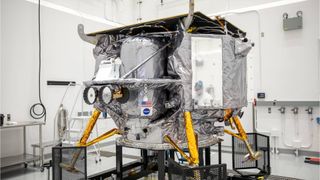
Astrobotic’s Peregrine moon lander is seen in a clean room before its Jan. 8, 2024 launch.
(Image credit: NASA/Isaac Watson)
Astrobotic has homed in on a potential cause for the problems plaguing its Peregrine moon lander.
Peregrine launched early Monday morning (Jan. 8) atop United Launch Alliance’s (ULA) new Vulcan Centaur rocket, with the goal of becoming the first private spacecraft to land softly on the moon.
That dream was dashed, however, by a propellant leak that sprang up shortly after Peregrine deployed from the rocket’s upper stage. Astrobotic has been troubleshooting and analyzing the issue ever since, and the company may now know what happened.
“Astrobotic’s current hypothesis about the Peregrine spacecraft’s propulsion anomaly is that a valve between the helium pressurant and the oxidizer failed to reseal after actuation during initialization,” company representatives wrote in a post on X Tuesday afternoon (Jan. 9).
“This led to a rush of high-pressure helium that spiked the pressure in the oxidizer tank beyond its operating limit and subsequently ruptured the tank,” they added.
Related: 1st photo from crippled private Peregrine moon lander holds clue about anomaly
Astrobotic has been impressively transparent about the Peregrine anomaly: Tuesday afternoon’s update was the eighth one that the company has posted on X since the leak occurred.
In update number seven, which Astrobotic posted earlier on Tuesday, the company announced that the fuel leak will prevent Peregrine from landing on the moon as planned. That update also stated that the lander is in a stable operating mode and has about 40 hours’ worth of propellant left.
Peregrine is carrying 20 payloads for a variety of customers, including NASA, which put five scientific instruments on the lander via the agency’s Commercial Lunar Payload Services (CLPS) program. None of these payloads will reach their intended destination.
The next CLPS liftoff will come next month, when Houston company Intuitive Machines’ Nova-C lander launches toward the moon atop a SpaceX Falcon 9 rocket.
Peregrine’s launch marked the long-awaited debut of Vulcan Centaur, which will replace ULA’s venerable Atlas V and Delta rockets. Vulcan Centaur did its job well on Monday, Astrobotic stressed.
The rocket “inserted Peregrine into the planned translunar trajectory without issue,” Astrobotic wrote in update number eight. “There is no indication that the propulsion anomaly occurred as a result of the launch.”
Join our Space Forums to keep talking space on the latest missions, night sky and more! And if you have a news tip, correction or comment, let us know at: [email protected].
Breaking space news, the latest updates on rocket launches, skywatching events and more!
Michael Wall is a Senior Space Writer with Space.com and joined the team in 2010. He primarily covers exoplanets, spaceflight and military space, but has been known to dabble in the space art beat. His book about the search for alien life, “Out There,” was published on Nov. 13, 2018. Before becoming a science writer, Michael worked as a herpetologist and wildlife biologist. He has a Ph.D. in evolutionary biology from the University of Sydney, Australia, a bachelor’s degree from the University of Arizona, and a graduate certificate in science writing from the University of California, Santa Cruz. To find out what his latest project is, you can follow Michael on Twitter.
>>> Read full article>>>
Copyright for syndicated content belongs to the linked Source : Space.com – https://www.space.com/astrobotic-peregrine-moon-lander-anomaly-valve































